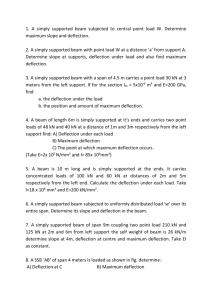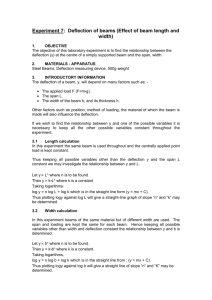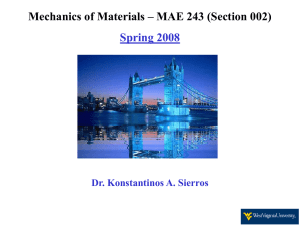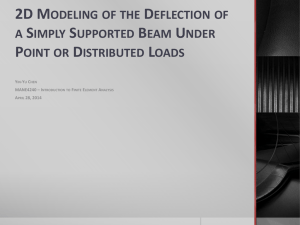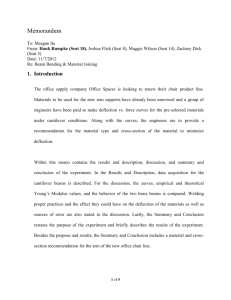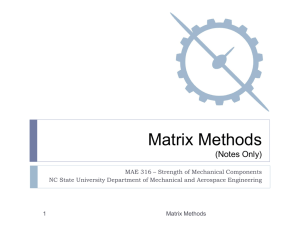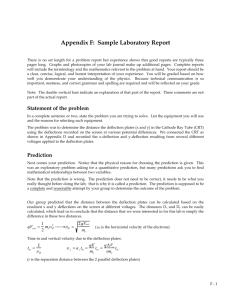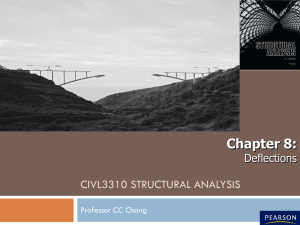Chapter 4 - Dr. ZM Nizam
advertisement
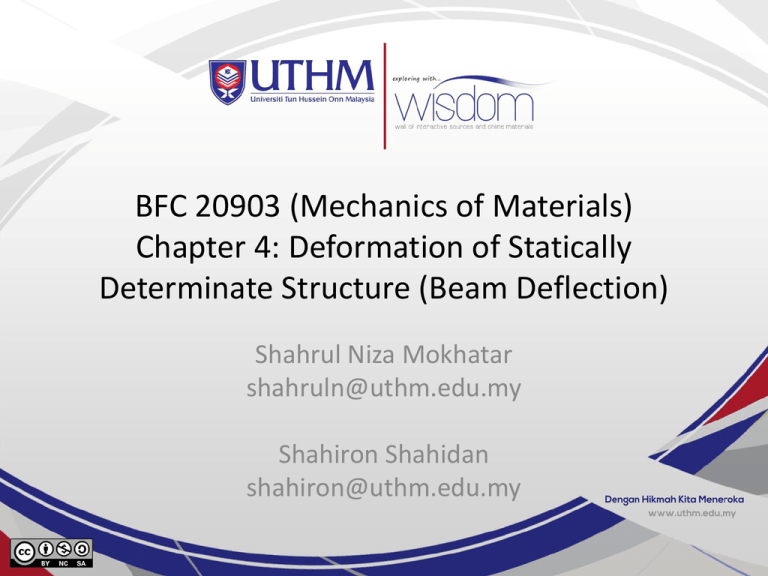
BFC 20903 (Mechanics of Materials) Chapter 4: Deformation of Statically Determinate Structure (Beam Deflection) Shahrul Niza Mokhatar shahruln@uthm.edu.my Shahiron Shahidan shahiron@uthm.edu.my Chapter Learning Outcome 1) Develop the general equation for the elastic curve of a deflected beam by using double integration method and area-moment method. 2) State the boundary conditions of a deflected beam 3) Determine the deflections and slopes of elastic curves of simply supported beams and cantilever beams. BFC 20903 (Mechanics of Materials) Shahrul Niza Mokhatar (shahrul@uthm.edu.my Introduction • • When a structure is placed under load - bend, deflect or displace. The deflection will depend on the following factors: – Geometry of the structure, including shape and flexural rigidity of member. – Flexibility/rigidity of the material used. – Restraint of the supports. – Load pattern • This chapter is intended as an introduction to the analytical techniques used for calculating deflections in beams and also for calculating the rotations at critical locations along the length of a beam Introduction • Load applied on the beam, it is often helpful to sketch the deflected shape before the slope or displacement at any point on a beam can be determined. • This deflection diagram called as an elastic curve. • However it is necessary to know how the slope or displacement is restricted at various types of supports. The zero slope and zero displacement occur at all fixed supports and zero displacement occurs at all pin and roller support. Deflection of Beams The deflection is measured from the original neutral surface of the beam to the neutral surface of the deformed beam. The configuration assumed by the deformed neutral surface is known as the elastic curve of the beam as shown in Figure Numerous methods are available for the determination of beam deflections. These methods include: 1. Double Integration Method 2. Moment Area Method 3. Strain Energy Method (Castigliano’s Theorem) 4. Conjugate Beam Method 5. Method of Superposition Double Integration Method • known as Macaulay’s Method and powerful tool in solving deflection and slope of a beam at any point because – – able to get the equation of the elastic curve – In calculus, the radius of curvature of a curve y = f(x) is given by 𝜌 = 3 [1+(𝑑𝑦 𝑑𝑥)2 ] 2 𝑑2 𝑦 The radius of curvature of a beam is given as 𝜌 = 𝐸𝐼 𝑀 𝑑𝑥2 – Deflection of beams is so small, the slope of the elastic curve dy/dx is very small, and squaring this expression the value becomes practically 1 1 negligible, hence 𝜌 = 𝑑2𝑦 = ,, 𝑑𝑥2 𝑦 • Thus, 𝑦 ,, = 𝑀 𝐸𝐼 = 1 M 𝐸𝐼 • If EI is constant, the equation may be written as: 𝐸𝐼𝑦 ,, = 𝑀 Where as: • x and y are the coordinates of elastic curve beam under load • y is the deflection of the beam at any distance x • E is the modulus of elasticity • I is the moment of inertia from NA • M is the bending moment at a distance x from the end of the beam • EI is called the flexural rigidity of the beam. • The resulting solution must contain two constants of integration since 𝐸𝐼𝑦 ,, = 𝑀 is of second order. – two constants must be evaluated from known conditions concerning the slope deflection at certain points of the beam. • For instance, in the case of a simply supported beam with rigid supports, at x = 0 and x = L, the deflection y = 0, and in locating the point of maximum deflection, we simply set the slope of the elastic curve y' to zero. Equation to determine deflection 1) 2) 3) 4) 5) Boundary Condition • Generally, the deflections is known as y-values and slopes is known as dx/dy. The values are called boundary conditions, which normally are: • Cantilever beam • Simply support When , x = L, deflection, y = 0 x = L, slope, dy/dx = 0 When , x = 0, deflection, y = 0 x = L, deflection y= 0 x = L/2, slope dy/dx = 0 • Cantilever at one free end When , x = L, deflection, y = 0 x = L, slope, dx/dy = 0 x = L + L1, deflection y= 0 Example • The cantilevered beam with length, L shown in figure is subjected to a vertical load, P at its end. Determine the maximum slope and deflection using double integration method. EI is constant. Free body diagram Example 1 Moment Area Method • Defined as semi-graphical technique. • Suitable to calculate the slope of tangents or the vertical deviationdeflection at selected points on a beam. – It requires finding area segments under the M/EI diagram on the elastic curve. • Procedure for beam analysis can be summarized as; – Calculate the support reactions – Draw the M/EI diagram – Select the reference tangent, t either • a known point with zero slope • determine tangential deviation of one support and the other also finding the angle. Theorem Theorem 1 – Slope – The change in slope between the tangents drawn to the elastic curve at any two points A and B – is equal to the product of 1/EI multiplied by the area of the moment diagram between these two points. 𝜽𝑨𝑩 𝟏 = (𝑨𝒓𝒆𝒂𝑨𝑩 ) 𝑬𝑰 Theorem 2 – Deflection • The deviation of any point B relative to the tangent drawn to the elastic curve at any other point A, in a direction perpendicular to the original position of the beam, – is equal to the product of 1/EI multiplied by the moment of an area about B of that part of the moment diagram between points A and B. 𝒕𝑨/𝑩 𝟏 = 𝑨𝒓𝒆𝒂𝑨𝑩 . Ẋ𝑩 𝑬𝑰 𝒕𝑩/𝑨 𝟏 = 𝑨𝒓𝒆𝒂𝑨𝑩 . Ẋ𝑨 𝑬𝑰 Basic principles • The bending moment caused by all forces to the left or to the right of any section is equal to the respective algebraic sum of the bending moments at that section caused by each load acting separately; 𝑴 = 𝚺𝑴 𝑳 = 𝚺𝑴 𝑹 • The moment of a load about a specified axis is always defined by the equation of a spandrel; 𝒀 = 𝒌𝒙𝒏 • where n is the degree of power of x • The graph of the above equation is as shown below Area, A and location of centroid, XG 𝟏 𝑨= 𝒃𝒉 𝒏+𝟏 𝟏 𝑿𝑮 = 𝒃 𝒏+𝟐 Example 2– Calculate moment-area 1) Calculate the reaction force 2) Draw the bending moment or M/EI diagram 3) Define the area and centroid of the diagram, then calculate the moment-area by multiplying area and centroid. Calculation of deflection and slope using theorem I and theorem II 1) 2) 3) 3) Tutorial 1 Tutorial 2 Tutorial 3 - END -
